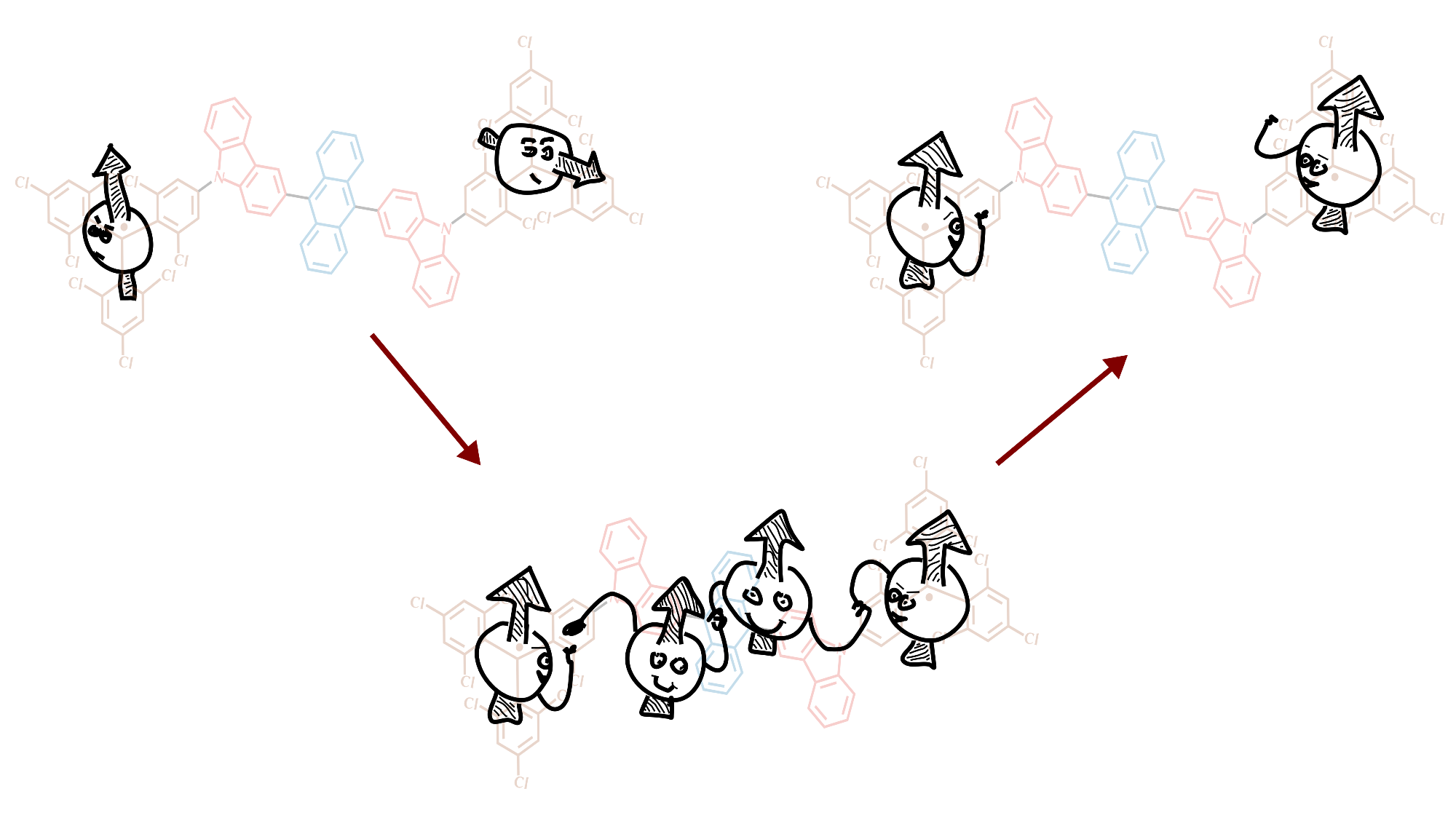Researchers have found a way to control the interaction of light and quantum ‘spin’ in organic semiconductors that works even at room temperature.

Image Credit: Sebastian Gorgon
Spin is the term for the intrinsic angular momentum of electrons, which is referred to as up or down. Using the up/down spin states of electrons instead of the 0 and 1 in conventional computer logic could transform the way in which computers process information. And sensors based on quantum principles could vastly improve our abilities to measure and study the world around us.
An international team of researchers, led by the University of Cambridge, has found a way to use particles of light as a ‘switch’ that can connect and control the spin of electrons, making them behave like tiny magnets that could be used for quantum applications.
The researchers designed modular molecular units connected by tiny ‘bridges’. Shining a light on these bridges allowed electrons on opposite ends of the structure to connect to each other by aligning their spin states. Even after the bridge was removed, the electrons stayed connected through their aligned spins.
This level of control over quantum properties can normally only be achieved at ultra-low temperatures. However, the Cambridge-led team has been able to control the quantum behaviour of these materials at room temperature, which opens up a new world of potential quantum applications by reliably coupling spins to photons. The results are reported in the journal Nature.
Almost all types of quantum technology – based on the strange behaviour of particles at the subatomic level – involve spin. As they move, electrons usually form stable pairs, with one electron spin up and one spin down. However, it is possible to make molecules with unpaired electrons, called radicals. Most radicals are very reactive, but with careful design of the molecule, they can be made chemically stable.
“These unpaired spins change the rules for what happens when a photon is absorbed and electrons are moved up to a higher energy level,” said first author Sebastian Gorgon, from Cambridge’s Cavendish Laboratory. “We’ve been working with systems where there is one net spin, which makes them good for light emission and making LEDs.”
Gorgon is a member of Professor Sir Richard Friend’s research group, where they have been studying radicals in organic semiconductors for light generation, and identified a stable and bright family of materials a few years ago. These materials can beat the best conventional OLEDs for red light generation.
“Using tricks developed by different fields was important,” said Dr Emrys Evans from Swansea University, who co-led the research. “The team has significant expertise from a number of areas in physics and chemistry, such as the spin properties of electrons and how to make organic semiconductors work in LEDs. This was critical for knowing how to prepare and study these molecules in the solid state, enabling our demonstration of quantum effects at room temperature.”
Organic semiconductors are the current state-of-the-art for lighting and commercial displays, and they could be a more sustainable alternative to silicon for solar cells. However, they have not yet been widely studied for quantum applications, such as quantum computing or quantum sensing.
“We’ve now taken the next big step and linked the optical and magnetic properties of radicals in an organic semiconductor,” said Gorgon. “These new materials hold great promise for completely new applications, since we’ve been able to remove the need for ultra-cold temperatures.”
“Knowing what electron spins are doing, let alone controlling them, is not straightforward, especially at room temperature,” said Friend, who co-led the research. “But if we can control the spins, we can build some interesting and useful quantum objects.”
The researchers designed a new family of materials by first determining how they wanted the electron spins to behave. Using this bottom-up approach, they were able to control the properties of the end material by using a building block method and changing the ‘bridges’ between different modules of the molecule. These bridges were made of anthracene, a type of hydrocarbon.
For their ‘mix-and-match’ molecules, the researchers attached a bright light-emitting radical to an anthracene molecule. After a photon of light is absorbed by the radical, the excitation spreads out onto the neighbouring anthracene, causing three electrons to start spinning in the same way. When a further radical group is attached to the other side of the anthracene molecules, its electron is also coupled, bringing four electrons to spin in the same direction.
“In this example, we can switch on interaction between two electrons on opposite ends of the molecule by aligning electron spins on the bridge absorbing a photon of light,” said Gorgon. “After relaxing back, the distant electrons remember they were together even after the bridge is gone.
“In these materials we’ve designed, absorbing a photon is like turning a switch on. The fact that we can start to control these quantum objects by reliably coupling spins at room temperature could open up far more flexibility in the world of quantum technologies. There’s a huge potential here to go in lots of new directions.”
“People have spent years trying to get spins to reliably talk to each other, but by starting instead with what we want the spins to do and then the chemists can design a molecule around that, we’ve been able to get the spins to align,” said Friend. “It’s like we’ve hit the Goldilocks zone where we can tune the spin coupling between the building blocks of extended molecules.”
The advance was made possible through a large international collaboration – the materials were made in China, experiments were done in Cambridge, Oxford and Germany, and theory work was done in Belgium and Spain.
The research was supported in part by the European Research Council, the European Union, the Engineering and Physical Sciences Research Council (EPSRC), part of UK Research and Innovation (UKRI), and the Royal Society. Richard Friend is a Fellow of St John’s College, Cambridge.